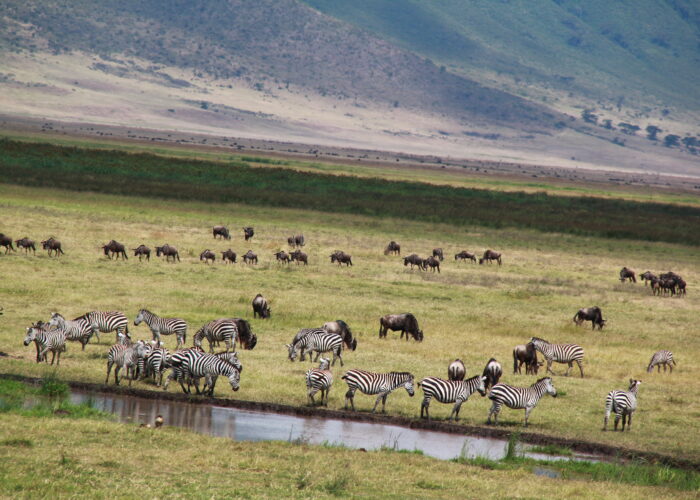Day 1:
Depart from Arusha town at 0900hrs with picnic lunch for Lake Manyara park game drives, dinner and overnight at Lake Manyara Hotel / Camp Site
Lake Manyara National Park is a small but scenic safari park, excellent for bird watching and a good area to find elephant, as well as the potential excitement of spotting a legendary Lake Manyara tree-climbing lion.
Lake Manyara is a good soft introduction to the safari experience. It is a magical and pretty park that winds its way around a mainly forested driving route between the banks of Soda Water Lake and the impressive rise of the Great Rift escarpment.
Elephant, giraffe, buffalo and wildebeest can be found grazing in unexpected clearings or heading towards the water to drink or wash, and the rivers and riverbeds provide scenic vistas for possible animal spotting.
Warthog seem to thrive here, growing notably fat and tuskered, and it is a natural playground for baboons and monkeys. The tree-climbing lion of Lake Manyara inspire extensive theorizing as to the wonders of evolution, and are also notoriously rarely seen.
Day 2:
Depart with picnic lunch for Serengeti park game drives en route, dinner and overnight at Seronera Wildlife Lodge /
Camp Site
This land is justifiably famous for its huge concentrations of wildlife, especially the big cats, as well as being the stomping ground of the Great Migration, a massive accumulation of 1.5 million wildebeest, 200,000 zebras and 350,000 gazelles stretching their legs over 1,200 miles in an annual race to find enough water and green grass for their survival.
The National Park is broadly divided into three distinct areas, the Seronera Valley and Seronera River, the Western Corridor and the Northern Lobo area that extends northwards through the Lamai Wedge to the Maasai Mara.
Most visitors enter the Serengeti through the southern Naabi Hill Gate, which opens onto the Seronera Valley; a vibrant wildlife area at the heart of the Serengeti.
Day 3 :
Full day Serengeti park game drives, all meals and overnight at
Seronera Wildlife Lodge / Camp Site
Day 4:
Early morning game drive at 0630hrs, late breakfast at 0930hrs, then drive to Ndutu for dinner and overnight at Ndutu Lodge/Camp Site
Day 5 :
Full day Ndutu area game drives, all meals and overnight at Ndutu Lodge/Camp Site
Day 6 :
Full day Ndutu area game drives, all meals and overnight at Ndutu Lodge/Camp Site
Day 7 :
Early morning game drives in Ndutu area, late breakfast at lodge and short rest, lunch then drive to Ngorongoro, dinner and overnight at Ngorongoro Wildlife Lodge / Camp Site
Day 8:
After breakfast descent into the Crater with picnic lunch for game drives, then drive to Karatu for dinner and overnight at Rhotia Valley Tented Lodge / Camp Site
Ngorongoro is a fascinating and unusual Conservation Area which includes the Ngorongoro Crater at its centre, and then extends through the Crater Highlands, in which local tribes are permitted to maintain their traditional lifestyles in as natural environment as possible.
This extraordinary volcanic landscape is rich and fertile, with stunning craters and lakes, and the high altitude creates a malaria-free micro climate.
The crater is said to have the densest concentration of wildlife in Africa. As such, Ngorongoro Crater has achieved world renown, and attracts a growing number of visitors each year. Even if time is limited this natural but accessibly small caldera ensures a rewarding safari.
-The Ngorongoro Crater is the world’s largest intact caldera in an exceptional geographical position, forming a spectacular bowl of about 265 sq km with sides up to 600m deep. It is the stalking ground of 20 – 30,000 wild animals at any one time.
The crater floor consists of a number of ecological environments that include grassland, swamps, forests and Lake Makat, a central soda lake filled by the Munge river. All these various habitats attract various wildlife to drink, wallow, graze, hide or climb.
-Although animals are free to move in and out of this contained environment, the rich volcanic soil, lush forests and spring source lakes on the crater floor tend to incline both grazers and predators to remain throughout the year.
-Ngorongoro Crater is also presently one of the most likely areas in Tanzania to see the endangered Black Rhino, as small populations are thriving in this idyllic and protected environment one of the only areas where they continue to breed in the wild.
-The Crater rim, over 2,200 metres high, touches swathes of clouds for most days of the year, with cool high altitude vapours that seem to bring a clean lightness to the air, and also a chill. These highlands wake up to a misty fog in most months.
Day 9:
After breakfast drive to Arusha Town.
Lodge Safari: Price per person sharing US $ 3420
Camping Safari: Price per person sharing US $ 2365

